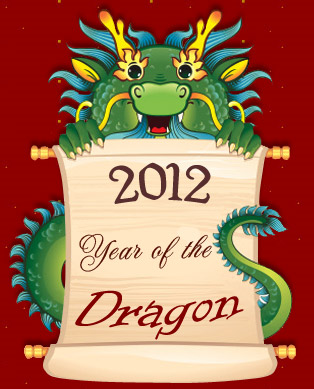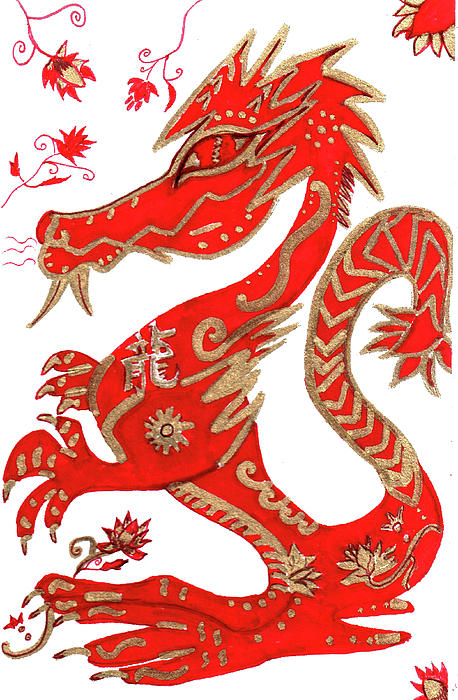 |
| (Chinese New Year is on 23rd Jan. 2012) Expect this to be a very energetic year, filled with optimism, power and entrepreneurship. However, the year is of water dragon, which means that even the most powerful will give a patient hearing to the weaker, and will try to see through their point of view. Better alliances and decision will take place. |
Chinese New Year starts with the New Moon on the first day of the new year and ends on the full moon 15 days later. The 15th day of the new year is called the Lantern Festival, which is celebrated at night with lantern displays and children carrying lanterns in a parade. The Chinese calendar is based on a combination of lunar and solar movements. The lunar cycle is about 29.5 days. In order to "catch up" with the solar calendar the Chinese insert an extra month once every few years (seven years out of a 19-yearcycle). This is the same as adding an extra day on leap year. This is why, according to the solar calendar, the Chinese New Year falls on a different date each year. New Year's Eve and New Year's Day are celebrated as a family affair, a time of reunion and thanksgiving. The celebration was traditionally highlighted with a religious ceremony given in honor of Heaven and Earth, the gods of the household and the family ancestors. The sacrifice to the ancestors, the most vital of all the rituals, united the living members with those who had passed away. Departed relatives are remembered with great respect because they were responsible for laying the foundations for the fortune and glory of the family.
Year 2012 is the Year of the Dragon by the Chinese calendar.
 |
The History of Chinese New Year
The Chinese New Year has a great history. In our past, people lived in an agricultural society and worked all year long. They only took a break after the harvest and before the planting of seeds. This happens to coincide with the beginning of the lunar New Year.
The Chinese New Year is very similar to the Western one, rich in traditions, folklores and rituals. It has been said that it is a combination of the Western Thanksgiving, Christmas and New Year. This is hardly an exaggeration!
The origin of the Chinese New Year itself is centuries old - in fact, too old to actually be traced. It is popularly recognized as the Spring Festival and celebrations last 15 days.
Preparations tend to begin a month before the date of the Chinese New Year (similar to a Western Christmas). During this time people start buying presents, decoration materials, food and clothing. A huge clean-up gets underway days before the New Year, when Chinese houses are cleaned from top to bottom. This ritual is supposed to sweep away all traces of bad luck. Doors and windowpanes are often given a new coat of paint, usually red, then decorated with paper cuts and couplets with themes such as happiness, wealth and longevity printed on them.
The eve of the New Year is perhaps the most exciting part of the holiday, due to the anticipation. Here, traditions and rituals are very carefully observed in everything from food to clothing. Dinner is usually a feast of seafood and dumplings, signifying different good wishes. Delicacies include prawns, for liveliness and happiness, dried oysters ( ho xi), for all things good, fish dishes or Yau-Yu to bring good luck and prosperity, Fai-chai (Angel Hair), an edible hair-like seaweed to bring prosperity, and dumplings boiled in water (Jiaozi) signifying a long-lasting good wish for a family. It is customary to wear something red as this colour is meant to ward off evil spirits. But black and white are frowned upon, as these are associated with mourning. After dinner, families sit up for the night playing cards, board games or watching television programmes dedicated to the occasion. At midnight, fireworks light up the sky.
On the day itself, an ancient custom called Hong Bao, meaning Red Packet, takes place. This involves married couples giving children and unmarried adults money in red envelopes. Then the family begins to say greetings from door to door, first to their relatives and then to their neighbours. Like the Western saying "let bygones be bygones," at Chinese New Year, grudges are very easily cast aside.
 |
Tributes are made to ancestors by burning incense and the symbolic offering of foods. As firecrackers burst in the air, evil spirits are scared away by the sound of the explosions.
The end of the New Year is marked by the Festival of Lanterns, which is a celebration with singing, dancing and lantern shows.
At the Festival, all traditions are honored. The predominant colors are red and gold. "Good Wish" banners are hung from the ceilings and walls. The "God of Fortune" is there to give Hong Baos. Lion dancers perform on stage continuously. Visitors take home plants and flowers symbolizing good luck. An array of New Years specialty food is available in the Food Market. Visitors purchase new clothing, shoes and pottery at the Market Fair. Bargaining for the best deal is commonplace!
Traditions of Chinese New Year
Even though the climax of the Chinese New Year, Nian, lasts only two or three days including the New Year's Eve, the New Year season extends from the mid-twelfth month of the previous year to the middle of the first month of the new year. A month from the New Year, it is a good time for business. People will pour out their money to buy presents, decoration material, food and clothing. Transportation department, railroad in particular, is nervously waiting for the onslaught of swarms of travelers who take their days off around the New Year to rush back home for a family renunion from all parts of the country.
Days before the New Year, every family is busy giving its house a thorough cleaning, hoping to sweep away all the ill-fortune there may have been in the family to make way for the wishful in-coming good luck. People also give their doors and window-panes a new paint, usually in red color. They decorate the doors and windows with paper-cuts and couplets with the very popular theme of "happiness", "wealth", "logevity" and "satisfactory marriage with more children". Paintings of the same theme are put up in the house on top of the newly mounted wall paper. In the old days, various kinds of food are tributed at the alta of ancestors.
 |
The Eve of the New Year is very carefully observed. Supper is a feast, with all members coming together. One of the most popular course is jiaozi, dumplings boiled in water. "Jiaozi" in Chinese literally mean "sleep together and have sons", a long-lost good wish for a family. After dinner, it is time for the whole family to sit up for the night while having fun playing cards or board games or watching TV programs dedicated to the ocassion. Every light is supposed to be kept on the whole night. At midnight, the whole sky will be lit up by fireworks and firecrackers make everywhere seem like a war zone. People's excitement reach its zenith.
Very early the next morning, children greet their parents and receive their presents in terms of cash wrapped up in red paper packages from them. Then, the family start out to say greetings from door to door, first their relatives and then their neighbors. It is a great time for reconciliation. Old grudges are very easily cast away during the greetings. The air is permeated with warmth and friendliness. During and several days following the New Year's day, people are visiting each other, with a great deal of exchange of gifs. The New Year atmosphere is brought to an anti-climax fifteen days away where the Festival of Lanterns sets in. It is an occasion of lantern shows and folk dances everywhere. One typical food is the Tang Yuan, another kind of dumplings made of sweet rice rolled into balls and stuffed with either sweet or spicy fillings.
The Lantern Festival marks the end of the New Year season and afterwards life becomes daily routines once again. This description is based upon the recollection of my own experience. Customs of observing the New Year vary from place to place, considering that China is a big country not only geographically, but also demographically and ethnically. Yet, the spirit underlying the diverse celebrations of the Chinese New Year is the same: a sincere wish of peace and happiness for the family members and friends.
 |
The History and Origin of Chinese New Year
The Chinese New Year is now popularly known as the Spring Festival because it starts from the Beginning of Spring (the first of the twenty-four terms in coordination with the changes of Nature). Its origin is too old to be traced. Several explanations are hanging around. All agree, however, that the word Nian, which in modern Chinese solely means "year", was originally the name of a monster beast that started to prey on people the night before the beginning of a new year (Do not lose track here: we are talking about the new year in terms of the Chinese calendar).
One legend goes that the beast Nian had a very big mouth that would swallow a great many people with one bite. People were very scared. One day, an old man came to their rescue, offering to subdue Nian. To Nian he said, "I hear say that you are very capable, but can you swallow the other beasts of prey on earth instead of people who are by no means of your worthy opponents?" So, swallow it did many of the beasts of prey on earth that also harassed people and their domestic animals from time to time.
After that, the old man disappeared riding the beast Nian. He turned out to be an immortal god. Now that Nian is gone and other beasts of prey are also scared into forests, people begin to enjoy their peaceful life. Before the old man left, he had told people to put up red paper decorations on their windows and doors at each year's end to scare away Nian in case it sneaked back again, because red is the color the beast feared the most.
 |
From then on, the tradition of observing the conquest of Nian is carried on from generation to generation. The term "Guo Nian", which may mean "Survive the Nian" becomes today "Celebrate the (New) Year" as the word "guo" in Chinese having both the meaning of "pass-over" and "observe". The custom of putting up red paper and firing fire-crackers to scare away Nian should it have a chance to run loose is still around. However, people today have long forgotten why they are doing all this, except that they feel the color and the sound add to the excitement of the celebration.
Chinese Zodiacs






Tidak ada komentar:
Posting Komentar